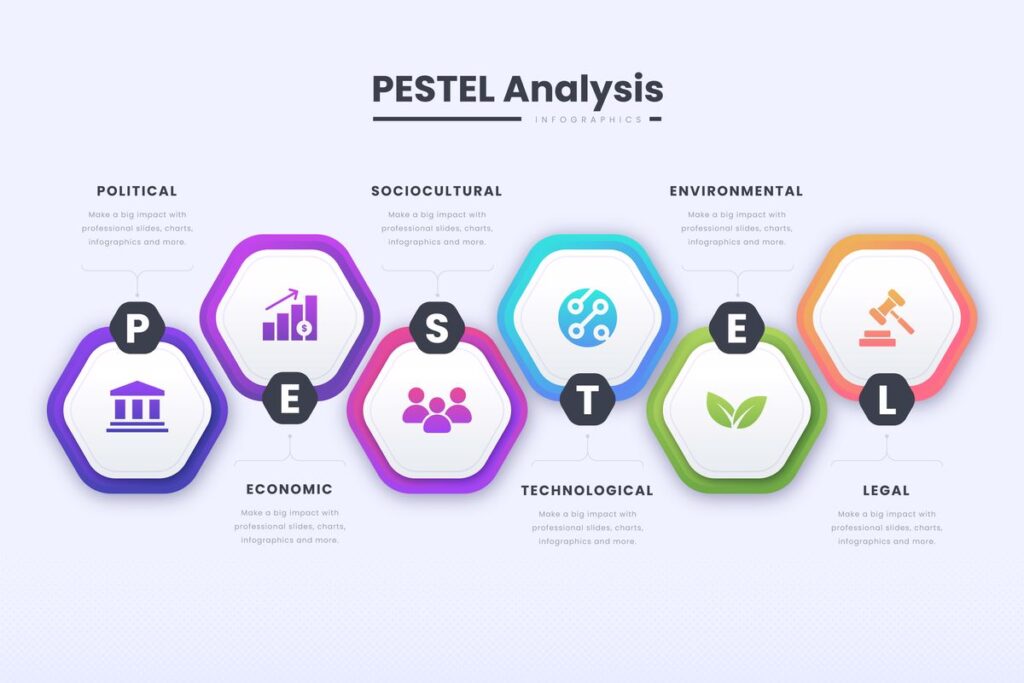PESTEL analysis is an effective method in analyzing the external environment, which is very important for many businesses. This method helps businesses to better understand how various factors such as political, economic, social, technological, environmental and legal affect their business.
Considering that the PESTEL analysis is a tool that is used in many industries, companies and businesses, it is extremely important that an accurate and correct analysis of the external environment is carried out in order to make the best use of it.
In this article, the concept and importance of PESTEL analysis, its various factors and how to implement it in businesses will be discussed. Also, to read more articles about business organization, you can refer to the articles page.
What is PESTEL Analysis?
It is a management tool used to analyze the organization’s external environment. This tool includes six different factors that are useful in examining and analyzing the organization’s external environment. The factors that are examined in the PESTEL analysis are:
•Political
•Economic
•Social
•Technology
•Environmental
•Legal
PESTEL analysis helps managers to get to know the external environment of their organization and use it for better planning and better decisions. For example, by analyzing political factors, managers can investigate the effects of government policies on their business. By analyzing economic factors, managers can analyze economic growth, inflation rate and productivity rate and check its effect on their business. Also, by analyzing social factors, managers can investigate social, cultural and religious events and their role in the success of their business.
By analyzing technology factors, managers can analyze the effects of technology on their business. By analyzing environmental factors, managers can investigate environmental effects such as climate change, television, social media, etc. on their business. Finally, by analyzing legal factors, managers can examine the effects of laws and regulations on their business.

Sections of PESTEL Analysis
PESTEL analysis is a strategic tool for analyzing the external business environment. This tool is used to identify and examine the factors that influence the external environment of the business. PESTLE stands for Politics, Economics, Society, Technology, Environment and Legal.
Political Factors
These factors are related to government policies, laws, regulations and international relations. Some of the questions managers can answer are:
How have business laws and regulations changed?
Do sanctions or diplomatic issues affect our business?
How does international communication affect our customers and competitors?
Economic Factors
These factors are related to the economic situation, changes in exchange rates and prices, employment and other issues related to the economy. Some of the questions managers can answer are:
1.How does the economic situation, market and exchange rate affect our business?
2.How does market competition affect our prices and revenue?
3.How do sanctions, debt and other financial issues affect our business?
Society Factors
These factors are related to issues such as culture, values, attitudes, needs and preferences of society. Some of the questions managers can answer are:
How do customer need and preferences affect our business?
How do demographic changes affect our market?
Are more customers interested in sustainable and ethical products?
Technology Factors
These factors are related to technological advances, innovations and changes in technology. Some of the questions managers can answer are:
How do technological advances affect our business?
How do changes in technology affect our production, marketing and sales process?
Can the Internet of Things, artificial intelligence and other new technologies help us do better business?
Environmental Factors
These factors are related to environmental and ecological issues. Some of the questions managers can answer are:
How does climate change affect our business?
Can the consumption of natural resources and environmental protection help us achieve more marketable products and services?
How can we help the environment by managing waste and also reduce our costs?
Legal Factors
These factors are related to laws and regulations that affect the business. Some of the questions managers can answer are:
What laws and regulations exist in our business and how can we comply with them?
Can changes in laws and regulations help us reach more customers?
How does it affect our business that laws and regulations may be different in different regions?
Considering that PESTEL analysis can help managers and businesses to better understand and respond in the best way to the external environment, it is necessary to conduct a complete and comprehensive analysis of these factors. As a result, this analysis can help businesses strengthen their brand.
In the following, we discuss other influencing factors:
Social Factors
These factors are related to different societies and cultures that affect business. Some of the questions managers can answer are:
What changes are observed in customer habits and behaviors and how can we plan the best strategy to respond to these changes?
Can changes in society’s tastes and interests help us to lead the market with products and services that suit them?
How can we reach more customers by taking advantage of events and discount days?
Technological Factors
These factors are related to technological developments that affect the business. Some of the questions managers can answer are:
What changes in the technologies used by the business are predicted in the future?
Can we use new technologies to have a superior competition in the market?
How can we reduce costs and increase productivity by using technology solutions?
Economic Factors
These factors are related to economic issues such as economic growth, inflation rate, productivity rate and the rate of change in currency value. Some of the questions managers can answer are:
How will changes in inflation rate affect our business?
What actions should we take in response to changes in the exchange rate?
Can we invest in the development of our business by taking advantage of the market conditions?
Technological Factors
These factors in PESTEL analysis are related to technological developments such as new software, digital platforms, Internet of Things and artificial intelligence. Some of the questions managers can answer are:
Can we use new technologies to have a superior competition in the market?
How can we reduce costs and increase productivity by using technology solutions?
Can we achieve better access to customers by creating digital platforms?
Environmental Factors
These factors are related to environmental issues such as climate change, energy consumption, and environmental issues. Some of the questions managers can answer are:
Should we implement a new strategy for our business in the face of climate change?
How can we be more responsible for protecting the environment?
Social Factors
These factors are related to social issues such as changes in people’s consumption patterns, changes in lifestyle, and changes in social values and beliefs. Some of the questions managers can answer are:
Can we create a fit between our products and customers’ needs, considering the changes in people’s consumption patterns?
How can we respond to the social concerns of our customers and establish positive connections with them?
Legal Factors
These factors are related to legal issues such as government laws and regulations, contracts, and financial and ownership issues. Some of the questions managers can answer are:
Are we sufficient in complying with government laws and regulations?
How can we use legal tools to reduce risks when faced with financial and property issues?
Local factors: These factors are related to local issues such as culture, history, language, and political issues. Some of the questions managers can answer are:
Have we paid enough attention to the cultural and historical concerns of the region in which we operate?
Can we establish positive interactions with the government and other local institutions regarding political issues?
Environmental Factors
These factors are related to environmental issues, such as climate change, natural disasters (such as earthquakes and floods), air and water pollution, biodiversity loss, etc., according to these factors, businesses can adjust their strategies to meet the environment. be bio compatible and at the same time try to protect it.

Legal Factors
These factors are related to laws and regulations that are determined by the government or other governing institutions in the country. Some of these laws include financial regulations, environmental regulations, labor laws, etc. Businesses must ensure that all their activities comply with local laws or they may face legal problems.
Technical Factors
These factors are related to technological developments that can have a direct impact on businesses. Some of these factors include information technology innovations, manufacturing technology, communication capabilities, etc. Businesses must continuously invest in new technologies in order to compete with market developments.
Social Factors
These factors include issues related to culture, behaviors and social values that can have a direct impact on businesses. Some of these factors include consumer preferences, public opinion, social issues, etc.
Businesses should pay attention to these factors and consider appropriate strategies to improve performance and increase profits. For example, if consumer preferences regarding nutritional products have changed, it may be necessary for businesses related to this industry to make changes in the manufacturing, packaging, and marketing processes of their products in order to be able to adapt to the preferences. Consumers, market competition.
Advantages of PESTEL Analysis
Advantages of PESTEL analysis include:
1.Improving planning and decision-making in the organization
2.Identifying opportunities and threats in the organization’s external environment
3.Predicting and determining better strategies for business
4.Increasing information about the organization’s external environment
5.Reducing risks related to decision-making in the organization
Disadvantages of PESTEL Analysis
But also PESTEL analysis has disadvantages, which are:
1. Limitations related to the analysis of the organization’s external environment
2. Expressing the effects of the external environment on business, but not expressing strategies to deal with threats and take advantage of business opportunities in this environment.
3. Basis for analyzing relationships between PESTEL factors and finding competitive advantage needs more detailed analysis.
Considering these cases, PESTEL analysis can be used as an effective tool in analyzing the organization’s external environment, but in order to take full advantage of it, other analytical tools should also be considered according to the conditions in the organization and its needs.
Up to Sum
In general, PESTEL analysis helps businesses identify their external environment and consider appropriate strategies to adapt to these conditions and compete in the market. According to the PESTEL analysis for an organization, we can conclude that for success in the market and sustainable growth, we must pay special attention to external and internal factors.
This analysis can help us to learn about market trends and competitors by examining political, economic, social, technological, environmental and legal factors, and to control the market and benefit from new opportunities with appropriate planning for these factors.
At the same time, issues such as rapid and unexpected changes in external and internal factors, new threats, non-compliance with laws and regulations, and competitors’ innovations should also be considered. However, PESTEL analysis is considered as a useful tool in the strategic decisions of organizations and can be effective in improving their performance and increasing their profitability. Stay with the specialists of Uprodemy website to get business advice and international trade.


